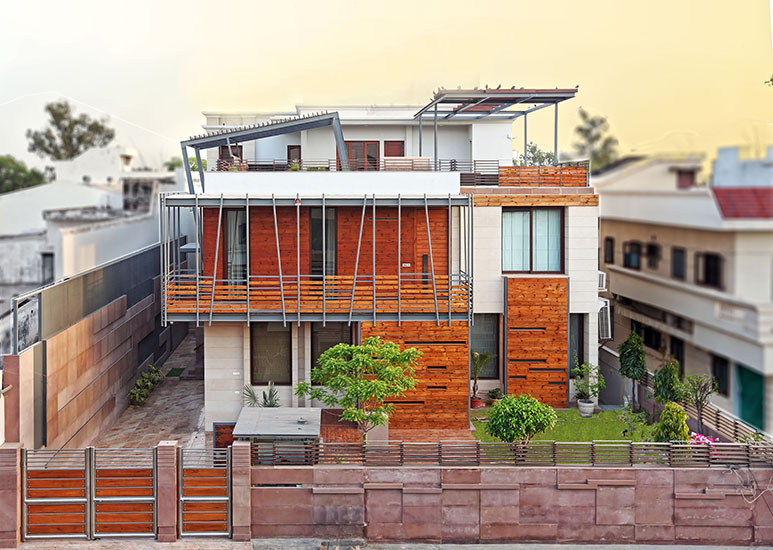
 This feature story is based on inputs drawn during an exclusive face-to-face interview with Nili Portugali, an esteemed architect from Israel.
This feature story is based on inputs drawn during an exclusive face-to-face interview with Nili Portugali, an esteemed architect from Israel.
It all lies in the details. According to Frank Lloyd Wright, an American architect, interior designer, writer, and educator, “Organic architecture seeks a superior sense of use and a finer sense of comfort, expressed in organic simplicity.” Following the trails set by Wright early on, into designing structures that are in harmony with humans and the environment around, Nili Portugali, a recognized architect from Israel shares her unique approach to organic architecture in an exclusive interview with us.
An organic approach to architectural design is seldom popularised by developers and less explored by architects globally owing to commercial viability concerns, as in proportion to the investment of time, people, and machinery involved to create such magnificent spaces of importance. A place, where humans experience surreal connect with the environment and nature to find peace.
If you are a business traveler or someone smitten by the travel bug to explore the world, there is a reason beyond the obvious missing comfort on why you always want to come back home. Home as most often referred to is a place where hearts live and souls dwell. Now going by the definition of an ideal experience called “home”, architects through time have been exploring various techniques and innovating new methodologies to perhaps even touch upon elements of Vastu, to integrate into the discipline of architecture and design spaces that exude positive energies.

Looking at the nature of the order, what are the foundations for harmony in architecture, questions Nili during her recent visit to India. She goes on to explain the difference between the sustainable and holistic approach to architecture implied when designing spaces that feel like home anywhere in the world. Embedding rich Jewish culture and drawing inspiration from Buddhism, she narrates how spiritual consciousness helps architects to connect organically with the ground before they get to their devices, to design and plan positioning of windows, door, entry and exit points to the building, elevators, lobby etc.
Sharing the experience of discovering universal insights, and unleashing the secret behind all those places we intuitively feel connected with, Nili explains the similarity in the pattern of things. She recently forayed into the world of art cinema with her first movie titled ‘And the Alley She Whitewashed in Light Blue.’ The narrative art movie illustrates the Zen experience, on why certain spaces establish connect at a deeper realm to our core of existence, lures us to fall prey to its charm and revisit them again in time. The movie was premiered recently at MIFF India on February 2, 2018.
Couple of challenges towards making this movie were translating works of organic architecture,
explaining concepts and the design process, emoting feelings (which can be quite subjective) of
treasured moments and memories at my grandmother’s home.
Delving into “Details”
Architects need to really understand specific patterns that communicate feelings of surreal connect with the universal energies that make people experience a feeling of oneness with the spaces. The positive energy exuded by such carefully designed spaces have a strong magnetic pull to make people revisit them in time to seek inner solace and find solitude.
Decoding the Secret
Immersing yourself in the power of now to feel connected with the real, and letting go of yourself to experience the universal calling and make design decisions based on what is there. This isn’t easy and architects do not have the luxury of time to dive deeper into awakening spiritual consciousness to experience emotions with a scientific rationale to the law and order of things.
Achieving such heights of immaculate architectural caliber requires commitment and in-depth understanding of subject expertise. Builders and developers generally question the holistic phenomenological approach to architecture under the purview of commercial viability, affordability, and sellable value.

Detailing upon pillars, one of the architectural patterns says, “Structure follows social spaces.” Today, it’s easy to create open spaces without a column. However, designing spaces with columns as required gives visitors a good feeling. Columns created in an open spacious area, do not confine or mark territories, however, on the contrary, connotes a feeling of a dedicated space area allocated for a living room, dining, study, recreation etc. Studying the Tel Aviv Music Centre designed by Nili, you will notice columns in areas that define the center of a lobby, offering visitors a sense of a place. “I work closely with engineers to identify and monitor where columns should be placed in the architectural building design. This is also one of the patterns.”
The Journey So Far…
Looking back in time as a student of architecture, Nili found inspiration from one of the famous book by Bernard Rudofsky titled, ‘Architecture without Architects.’ This book talks at length about vernacular architecture and the need to stick to traditional models of architectural design. Holistic phenomenological approach to architecture does not directly propagate or subtly communicate the need to do away with the old and embrace the new. On the contrary, it emphasizes on the thumb rules of design passed on from generations to create phenomenal artistic monuments and creations transcending time and space, to seem more relevant even today. This cannot be perfected as a mere coincidence.

It requires careful planning, in-depth research study, and the unspoken spiritual consciousness to hear silent voices from nature and intuitively connect with the foreseeable vision on the mind. To translate these strong emotions, you need to seek within for specific answers to bring order to randomness in thoughts and expression. This has nothing to do with theoretical learning acquired at acclaimed architectural institutes of credible repute and neither a matter of changing the style. It’s about the state of mind that reflects in designs when the theory is put to practice.
The Designing Process
Bringing this new methodology to design exemplary spaces that transcend time, age and eras, here is an example illustrating the approach to holistic design. For instance, if there are two windows on the same side at the two extreme opposite ends of a squared-room, first you have to allow yourself to let go of the thought behind the positioning of these windows. You should rather focus on the experience. Sit at each of these windows for a certain amount of time and closely observe your inner feelings. How do you feel? Does a window make you feel better than the other? If yes, what is the reason behind the way you feel? To explain, it is not about a matter of style, the structure, and the height of the windows, or the elevation of the room, if it’s square or oval-shaped window. Holistic or organic approach to architectural design deals with connecting universal energies to spatial planning. The process begins before you start putting pencil to paper, to perhaps create an outlet for a window or an entry-point of a house, a gated community and everything else. The rules to connect organically with surrounding elements of nature and envision an edifice do not change here.
Blending commercial viability to soulful design
Convincing developers about investing into holistic design structures isn’t easy. However, the revenues earned from the sale of such properties is at a much higher premium advantage over the affordable ordinary ones. Nili recently completed a housing project of 16 apartments, amidst bustling junction in a noisy crowded area. The challenge here was to eliminate the noise in the background and create peaceful surroundings. Understanding this need, she went on to create an internal street resembling much of an inner courtyard, with each apartment having its own entrance from the outside. The topmost floor entry is only possible from the elevator outside. Each residential apartment makes the owner find complete privacy as if owning a private villa.

There is no lobby and no internal staircase. In another one-of-its-kind residential project, there was a staircase with huge windows. Ample amount of sunlight beaming through the windows would brighten up the hall and living area all day. Thus saving on power and need for artificial lighting to light up spaces. Patterns of events are also created by the patterns of spaces. Technology provides tools to facilitate the creation of exquisite spaces, along with the understanding of scientific principles to ease architectural design process. Glass structures and eco-friendly buildings thus designed as sustainable architecture, lack organic connects with nature and the surrounding environments to only meet the purpose of economic efficiency, and not creative excellence. Traditional architecture in Israel for instance, a space called the wind room is designed to cool the house. This ventilated room would allow wind flow inside the house to keep the room temperature cold naturally, without the need for air conditioners.
Pathway for the Future
Academic institutions play a very important role in building architects of the future. They should train students’ right from basics to make them understand the importance of a line, and reason it out on why a line is drawn on the sketched draft. The same principle applies to column design as well.
Nili elucidates, “I think at any level of scale of the project, the details of the building should not be treated as ornaments or decorations. It’s a structural part of the building and one continuous whole. When you design a building, it’s not restricted to eco-friendly materials and the plan, but you need to think of a street as well. In today’s times, you can find new towns and new neighborhood, but you also need to prod and design an entrance to the building. It’s important to ask the right questions and find convincing answers to resolve major issues.”
Author’s Bio:
 An artist at heart driven by an innate passion to explore all mediums of creative expression, be it art, music, performing arts or literature, Savita V Jayaram is an established business journalist and writer who seeks to blend “skills for business with art” through her creative works. Delving deeper to understand the traditional concepts in art and architecture, culling through insights that date back in time to unleash the secret behind spaces we feel connected at the core and those we call “home away from home” – the ones wherein energies connect, bind and intertwine to give life a whole new meaning. Share your thoughts, feedback, and suggestions to bring in more meaning, valuable insights and depth to my stories while treading uncharted terrains during our continued association. Write into me at savita.v.jayaram[at]gmail.com. Cheers!
An artist at heart driven by an innate passion to explore all mediums of creative expression, be it art, music, performing arts or literature, Savita V Jayaram is an established business journalist and writer who seeks to blend “skills for business with art” through her creative works. Delving deeper to understand the traditional concepts in art and architecture, culling through insights that date back in time to unleash the secret behind spaces we feel connected at the core and those we call “home away from home” – the ones wherein energies connect, bind and intertwine to give life a whole new meaning. Share your thoughts, feedback, and suggestions to bring in more meaning, valuable insights and depth to my stories while treading uncharted terrains during our continued association. Write into me at savita.v.jayaram[at]gmail.com. Cheers!



